Gingivitis in Cats
GINGIVITIS IN CATS
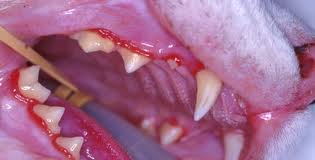
Gingivitis in cats is a frustrating disease for pet owners and vets alike. It often ends up being a disease that can’t be cured, merely controlled with repeated painful flare ups. [ad name=”Tweet”]
WHAT IS GINGIVITIS?
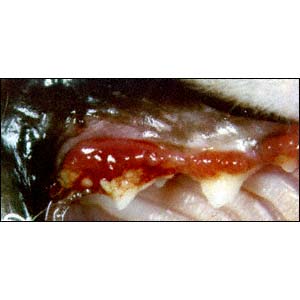
Gingivitis is strictly defined as inflammation of the gums in the mouth. It is most often seen on the gumline, where the gums meets the teeth. In mild gingivitis, a thin red line is seen, whereas in severe gingivitis the entire gum is often bright red, bleeding and often infected.
SYMPTOMS OF GINGIVITIS
Depending on the severity of the gingivitis, cats may show one or more of these symptoms.
- Cats slowly start avoiding hard foods, although they appear to be very hungry. They may try to eat and jump back suddenly when eating, and sometimes growl out of nowhere when they try to eat.

- Cats lose weight
- Halitosis or bad breath
- There is a bad fishy type smell coming from the cat, both from the mouth and the fur
- Cats may stop grooming themselves properly and the coat may appear dull
- Cats show pain when people try to open their mouth and may growl or scratch their owners or vets
- Cats may drool
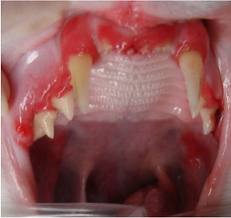
A typical case of what used to be known as lymphocytic plasmacytic gingivitis. - The gums are red and swollen, sometimes bleeding and sometimes have a layer of slime on them.
CAUSES OF GINGIVITIS
- Hypersensitivity to the bacterial load in the mouth. The name previously given to this hypersensitivity is lymphocytic plasmacytic gingivitis-stomatitis, now known as feline chronic gingivostomatitis (FCGS). The normal function of white blood cells in the body is to find bacteria and destroy them. In some cats, the body becomes over reactive to the number of bacteria in the mouth.
Signs that you are dealing with FCGS would include:
-severe, ulcerative gingivitis and not very much plaque on healthy looking teeth.
-inflammation/ulceration in the mouth such as at the back of the mouth down into the pharynx, where teeth have previously been extracted, and on the tongue as well as the gums. - -The gums appear to be thickened and nodular
-Inflammation that keeps coming back after treatment including antibiotics, steroids and dental cleaning. - Viral infections. Cats carrying certain viral infections, such as feline aids (FIV) and feline Leukaemia virus (Felv) will affect the immune system in the body which makes the body unable to destroy bacteria and infections as fast, allowing them to colonize the gumline and cause and infected mouth. Other viruses such as the feline Calici virus can cause ulcers in the mouth, especially on the tongue but other parts of the mouth can also be affected. Feline Corona virus may also play a role in gingivitis.
- Dental disease – rotten teeth, broken teeth, teeth with caries (holes) in them, teeth with roots that are broken or resorbed and tooth root abscesses, teeth that are not aligned properly or milk teeth that haven’t been removed can all be leading causes of gingivitis.
- Kidney failure. Cats in terminal kidney failure often have gingivitis as the toxins that are supposed to be excreted by the kidneys stay in the body and end up in the saliva, causing inflammation of the gums.
- Genetic predisposition to develop gingivitis. Seen in Oriental type breeds (Siamese, Persian,Himalayan) and Somali cats
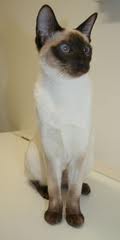
- Diabetic cats are more prone to gingivitis due to the high levels of sugar in their bloodstream on which the bacteria thrive
- Rare autoimmine diseases of the mouth and lips.
- Kittens have a form of gingivitis when the teeth erupt. This should settle down by just before a year of age.
- The Bartonella group (cat scratch disease) of bacteria have been implicated in causing this but there is little evidence to prove this.
- Cancerous growths in the mouth.
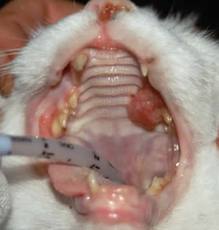
DIAGNOSIS
Most owners will bring their cat to the vet because of pain when eating or because their cat has been losing weight. When the vet tries to open the mouth to have a look, the cat is usually very painful and won’t allow a full oral examination. Most vets will get a quick glance of a very inflammed mouth, with or without tartar. Unfortunately because of the pain in these mouths, it is often impossible to get a good look inside.
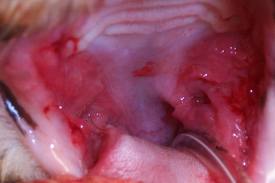
For this reason it is recommended that if your vet suspects gum or tooth disease, your cat should be sedated and a complete dental/oral examination with probing and exploration of all teeth and collection done. This includes examining the teeth, hard and soft palates, gums and the pharynx for disease, as well as probing inside the mouth for any problems and probing the depth of the gingival pockets to check to see if they are deeper than they should be, which would allow dirt, hair, bacteria and plaque to get stuck in the pocket causing an infection.The bone underlying the gum can also disappear making the pockets even deeper.

Your vet should also run a blood test to check for diseases such as kidney disease and diabetes. Many animals with severe dental disease have elevated liver enzymes because of the bacteria and dirt that gets absorbed into the bloodstream from the mouth. This blood flows through the liver and causes a mild inflammation in the liver. This is why dental hygiene in your pet is so important. Bacteria and dirt can also lodge in the kidneys and the heart valves causing permanent damage.
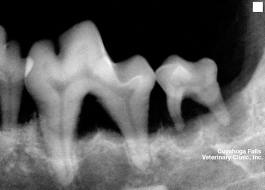
X rays of the mouth should be taken as well. This will give your vet the chance to examine all the teeth and the bone that surrounds them, to check for abscesses, bone loss, tooth root resorption and broken teeth as well as any other diseases of the mouth such as growths.
Your will will keep the x rays and record what he/she has seen in the mouth and recommend a plan to help your cat’s oral disease from that point on.
TREATMENT
It is important to treat oral disease properly from the outset. The sooner it gets properly treated, the sooner it can be controlled. It is important for owners to realise that many cases of FCGS can only be kept under control and most are never cured. This can cost more than owners would intially expect. A good London vet who does a scale and polish, extractions, bloods and full mouth x rays may end up charging you around 600 U.K. pounds. Other countries may differ – in South Africa this would cost normally around R3000.
What should happen when treating gingivitis in cats:
When your pet is sedated/anesthetized to have his/her mouth investigated, the vet will recommend the following treatments:
- A scale and polish to clean the teeth
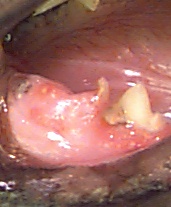
Half the tooth here is missing and the remainder should be removed as this will lead to gingivitis - If there are any resorption lesions in the tooth roots, any cavities (caries), any deep gingival pockets, any abscesses, any loose teeth or cracked teeth, your vet will recommend that the teeth be extracted.
- If there is any gingivitis that keeps on recurring despite all necessary cleaning and extractions having taken place, good oral care happening at home, then your vet will recommend removing the teeth from the mouth. In severe cases, all the teeth in the mouth behind the canines, and sometimes including the canine teeth will need to be removed. Many owners shy away from this idea thinking that it will be too painful for the cat. In reality, the severe inflammation in the mouth is far more painful than extracting the teeth will ever be.
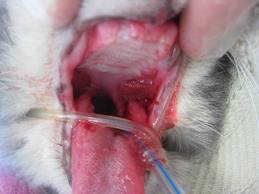
- Once your pet is awake, your vet will recommend a follow up check to see that the mouth is healing well and also send your pet home with painkillers, possibly antibiotics if the mouth was very infected and something to help keep your pet’s mouth hygienic in the future, such as oral gel to put on the gums (contains antibacterials to keep bacterial numbers in the mouth down), special food to help keep your pet’s mouth clean, antibacterial for the drinking water, toothpaste and tooth brush etc. Your pet should come every three months for a quick on the table check of the mouth to make sure the inflammation is resolving.
- Owners should be aware that it can take up to 6 weeks for inflammation in the mouth to go away after the teeth have been extracted.
- Some pets respond very well to full mouth extraction and the inflammation disappears completely, but some are unfortunately left with some inflammation in the mouth always. In most cases, removing the teeth makes them a lot more comfortable and gives them a better quality of life.
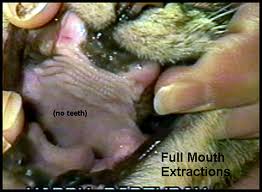
- Owners should be told that their cats can still eat hard food, once the mouth has healed up.
Animals should be rechecked after 6 weeks.
What often happens instead when treating gingivitis is cats:
- Animals are given an injection of a long acting steroid and/or antibiotic to control the oral inflammation.
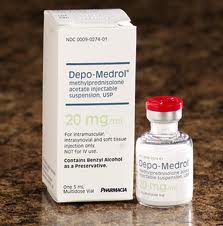
Depo medrol is a temporary measure - This will work temporarily, for between 14 days and 60 days. The gingivitis will always come back.
- Many owners cannot afford a full mouth workup and just want to go the cheaper route.
- Many owners shy away from the thought of removing teeth from their cat and want to try conservative treatment first.
- Some animals with this problem are very old or heave organ problems and will not handle a general anesthetic well.
- Owners should always be given the option of working the dental disease up properly with at the very least sedating the pet and examining the mouth and taking x rays. This way nasty things like tumours under the tongue won’t be missed.
- It often works very well initially but after a few injections the injections don’t seem to last as long.
- Long acting steroid injections are not without risks including an increased chance of the pet getting Diabetes mellitis and lowering the animal’s immunity. Used for along period of time, they can cause baldness of the belly and legs and even iatrogenic Cushing’s disease.
REFERENCES
http://www.toothvet.ca/PDFfiles/fcgs.pdf

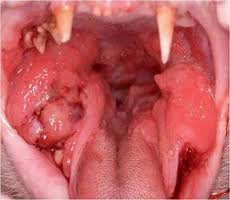
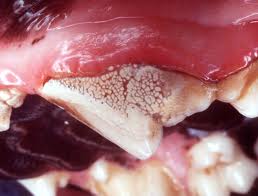
Leave a Reply
You must be logged in to post a comment.